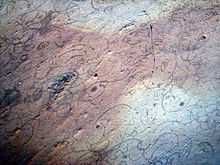Grypania
From Wikipedia, the free encyclopedia
| Grypania Temporal range: Paleoproterozoic–Mesoproterozoic | |
|---|---|
 | |
| Grypania spiralis fossil | |
| Scientific classification | |
| Domain: | Eukaryota |
| Genus: | †Grypania Walter, Oehler & Oehler, 1976[1] |
| Type species | |
| Grypania spiralis Walter, Oehler & Oehler, 1976 | |
Grypania is an early, tube-shaped fossil from the Proterozoic eon. The organism could have been a giant bacterium or bacterial colony, but because of its size (over one centimeter) and consistent form, is more likely[citation needed] to have been a eukaryotic alga. The oldest probable Grypania fossils date to about 2.1 billion years ago,[2] and the youngest extended into the Mesoproterozoic era. Grypania reproduced asexually [citation needed].
References
- ↑ M. R. Walter, John H. Oehler & Dorothy Z. Oehler (1976). "Megascopic algae 1,300 million years old from the Belt supergroup, Montana: a reinterpretation of Walcott's Helminthoidichnites". Journal of Paleontology 50 (5): 872–881. JSTOR 1303584.
- ↑ T. M. Han & B. Runnegar (1992). "Megascopic eukaryotic algae from the 2.1-billion-year-old negaunee iron-formation, Michigan". Science 257 (5067): 232–235. Bibcode:1992Sci...257..232H. doi:10.1126/science.1631544. PMID 1631544.
External links
This article is issued from Wikipedia. The text is available under the Creative Commons Attribution/Share Alike; additional terms may apply for the media files.